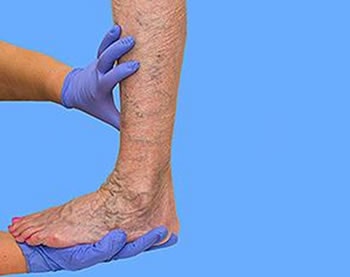Venous Insufficiency

What is Venous Insufficiency?
Venous insufficiency, sometimes referred to as chronic venous insufficiency (CVI), occurs when valves in the veins—that help move blood back to your heart-dysfunction and do not open. This condition occurs mostly in the legs and feet because veins there have to work against gravity to pump blood back up to the heart, which is far away.
What are Symptoms of Venous Insufficiency?
CVI causes damage to veins in the feet and legs, causing blood to pool there, and can produce symptoms ranging from uncomfortable to potentially dangerous:
- Swelling (edema) in the ankles and lower legs
- Leg cramps at night
- Tired, achy, or heavy-feeling legs
- A pins-and needles, tingling, or burning sensation in the legs
- Varicose veins
- Flaking, itchy, discolored, or leathery-looking skin on legs
- Open sores (ulcers) that can appear near the ankles
Possible Causes of Chronic Venous Insufficiency
CVI has a number of possible causes. The condition may be congenital, or due to changes in the veins or medical issues (such as deep vein thrombosis) that prevent valves in veins from closing properly. Being overweight, pregnant, or sitting/standing for prolonged periods can also cause CVI.
How Is Venous Insufficiency Diagnosed?
Your podiatrist will perform a careful examination of your feet and legs, looking for possible signs of venous insufficiency. Tests like MRIs to detect obstructions and blood flow, and vascular ultrasounds to locate damage in the veins, will help your podiatrist diagnose CVI, while ruling out other possible conditions. Additionally, they may want to do an assessment of your risk of peripheral artery disease (PAD) with an ankle brachial pressure index (ABPI) test—since PAD is also present in many people with CVI.
Possible Treatments for Chronic Venous Insufficiency
Your podiatrist will develop a treatment plan depending on any other medical conditions you may have and how far your CVI has progressed, including:
- Exercise such as walking, and flexing the feet and ankles
- Weight management
- Leg elevation throughout the day
- Compression therapy such as a medicated wrap (Unna boot), compression bandages, or compression stockings
- Anticoagulants to prevent or treat blood clots
- Antibiotics to treat skin infections and/or ulcers
- Nonsurgical treatments to eliminate or collapse varicose veins, or close up diseased veins
In some cases, surgical intervention is needed to heal ulcers and deal with damaged veins. Your podiatrist may use various procedures (some minimally invasive) to remove, cut off and tie, block off, or even reroute (bypass) blood around problem veins.
Chronic venous insufficiency is a progressive disease that can impact your daily life. Although CVI can’t be cured, a prompt diagnosis and expert care from your podiatrist can manage its symptoms and improve your quality of life.









